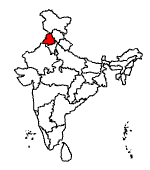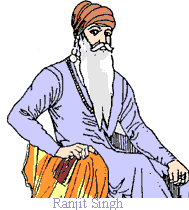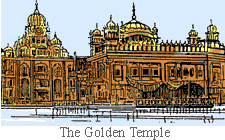
Dimdima
Online Children's Magazine from India

Dimdima
Online Children's Magazine from India
The word "Punjab" is a compound of two words, panj ("five") and ab ("water"), signifying the land of five waters, or the rivers - Beas, Chenab, Jhelum, Ravi, and Sutlej. However, after India's partition in 1947, only the Sutlej and the Beas now lie within Punjab.
Area : 50,362 sq km.
Population: 2,02,81,969
Main Language : Punjabi, the principal spoken language is written in the Gurmukhi script.
Capital : Chandigarh is the joint capital of Punjab and Haryana.
Religion :
More than 60 per cent of the people follow Sikhism, which originated from the teachings of Nanak, the first Sikh Guru.
Location :
Located in India's northwest, Punjab is bounded on the north by Jammu and Kashmir, on the east by Himachal Pradesh, on the south by Haryana and Rajasthan, and on the west by Pakistan. It assumed its present shape on November 1st, 1966, when most of the predominantly Hindi-speaking areas were separated to form the state of Haryana.
Physiography :
Most of Punjab is a gently undulating plain. The Shiwalik Hills rise in the northeast. To its south, extend narrow foothills that end in the plains further below.
Economy :
Punjab has the highest per capita income in the nation. Punjab's economy is characterized by a productive, highly commercial agriculture and a diversity of small and medium-scale industries. With less than 2% of India's total area, Punjab produces more than 10% of India's food grain and more wheat than all other states combined.
Punjab's phenomenal agricultural progress is largely due to the "Green Revolution", which introduced high-yielding varieties of wheat and rice seed along with modern farming technology. There has also been a rapid increase in the production of commercial fruit crops and cotton, groundnuts and vegetables.
The Bhakra Nangal dam in Himachal Pradesh and wells are the major sources of water for irrigation.
Major cities : Though about 30% of its people live in the urban areas, the major cities being Amritsar, Ludhiana, Jalandhar, and Patiala, 70 % of the state's population still depends on agriculture.
Climate : Because of its location in the interior, Punjab experiences hot summers and fairly cold winters, with night temperatures occasionally touching freezing point. More than 70% of the rainfall occurs from July to September, though the western cyclones bring rainfall in winter.
The Bhakra Nangal dam in Himachal Pradesh and wells are the major sources of water for irrigation.
Punjab became a satrapy of the Persian empire during the reign of Cyrus the Great in the 6th century BC. In the 4th century BC, Punjab became a part of Chandragupta Maurya's empire. The Indo-Greeks who settled in the Punjab in the 1st century BC were followed by the Kushans, Sakas and the Parthians. The fearsome Hun rulers, Toramana and Mihirakula also ruled over some parts of Punjab in the 5th and 6th centuries AD.
Mahmud of Ghazni, a ruler of Central Asia invaded Punjab in the 11th century. However, Ghazni's successors were weak, and the legendary Chauhana ruler, Prithviraj regained Punjab. It was Muhammad Ghori's victory at Tarain in 1192 that led to the establishment of the first of the Turko-Afghan empires in North India. Thereafter Punjab was ruled by whoever was ruling in Delhi.
The 15th and 16th centuries saw the advent of Sikhism. Originally, a socio-religious movement founded by Nanak, over a period of time, it acquired a militant flavour and challenged Mughal rule in northern India. Later Sikh Gurus like Guru Arjan Dev, and Guru Gobind Singh played important roles in the evolution of Sikhism.
Banda Singh Bahadur, a hermit turned military leader temporarily liberated the eastern part of the province from Mughal rule in 1709-10. Banda Singh's execution in 1716 was followed by a prolonged struggle between the Sikhs on the one side and the Mughals and Afghans on the other. But by the late 18th century, Ranjit Singh (1780-1839) had built up the Punjab into a powerful kingdom.
In 1849 the Punjab fell to the British and became a province under British rule. By the late 19th century, the Indian nationalist movement took hold in this province. One of the movement's most significant events – the Jallianwala Bagh massacre, took place at Amritsar in 1919. With independence in 1947, the British province of Punjab was split between India and Pakistan, and the smaller, eastern portion became part of India.
In November 1956, Punjab was enlarged by incorporation of the Patiala and East Punjab States Union (PEPSU), an amalgamation of the princely states. Modern Punjab came into being on 1st November 1966 when most of the Hindi speaking areas were separated from it and constituted into the state of Haryana. Punjab's capital, Chandigarh, became a separate union territory but still remains the capital of Haryana and Punjab.
Punjab's most famous landmark is the Golden Temple at Amritsar, the most revered of Sikh shrines. The fourth Guru Ram Das built the temple in 1579. The Lion of the Punjab, Ranjit Singh rebuilt the temple in the early 19th century in marble with a gilded dome.
Other noteworthy sites in Amritsar are the Durhiana Temple, a Hindu shrine with features resembling the Golden Temple's; the Rambagh Gardens and Jallianwala Bagh, a national monument honouring the martyrs of India's freedom movement.
Chandigarh, one of India's most well-planned cities, was designed by Le Corbusier. Notable buildings include the Secretariat, the High Court and the Legislative Assembly. In Ludhiana, now an industrial centre, the rural Olympics of Qila Raipur marked by boisterous bull races, the Chharpper Mela and Kila Mela attract lakhs every year.
Punjab holds numerous religious and seasonal festivals, such as Dussehra, Diwali, and Baisakhi, as well as anniversary celebrations in honour of Gurus and saints. Baisakhi (in April) is of special significance for it was on this day in 1689, that Guru Gobind Singh organised the Sikhs into the 'Khalsa'. During Basant (January/February), Punjabis welcome spring. As the mustard fields turn golden, Punjabis in yellow garments hold feasts and kite-flying competitions, and take part in community singing and dancing. These festivals are marked by the invigorating rhythms of the popular dances: the exuberant Bhangra and Gidda, a humorous song-dance, performed by women.
In addition to Sikh religious music, semi-classical Mughal forms, such as the khayal, thumri, ghazal, and qawwali, continue to be popular. The traditional dress worn by Punjabi women, salwar kameez is now worn all over India. The dress consists of a long kurta (shirt) and baggy trousers drawn in at the ankle. The dupatta, which is a long scarf, completes the outfit.



Dimdima is the Sanskrit word for ‘drumbeat’. In olden days, victory in battle was heralded by the beat of drums or any important news to be conveyed to the people used to be accompanied with drumbeats.
Bharatiya Vidya Bhavan
K. M Munshi Marg,
Chowpatty, Mumbai - 400 007
email : editor@dimdima.com
Bharatiya Vidya Bhavan
505, Sane Guruji Marg,
Tardeo, Mumbai - 400 034
email : promo@dimdima.com
Dimdima.com, the Children's Website of Bharatiya Vidya Bhavan launched in 2000 and came out with a Printed version of Dimdima Magazine in 2004. At present the Printed Version have more than 35,000 subscribers from India and Abroad.